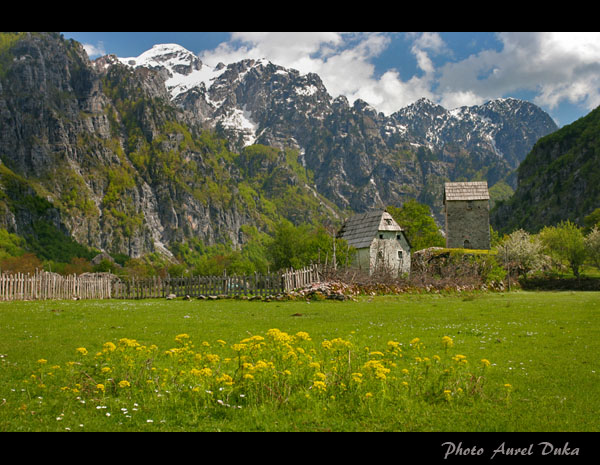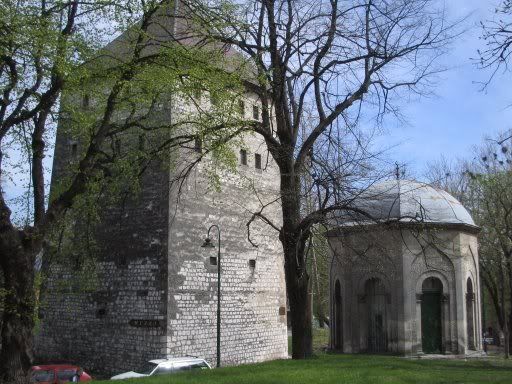


Notice: This is the official website of the All Empires History Community (Reg. 10 Feb 2002)
Fortified Homes |
Post Reply 
|
Page 12> |
| Author | ||
Theodore Felix 
General 

Joined: 10-Jan-2006 Location: United States Online Status: Offline Posts: 769 |
 Quote Quote  Reply Reply
 Topic: Fortified Homes Topic: Fortified HomesPosted: 12-Dec-2007 at 04:04 |
|
|
Kulla/� comes from the Turkish word kule meaning tower. It was a house built high and principally made up of stone. It contained few windows and small ones, built ideally as close to the ceiling as possible, so as to protect from attacks, which was a constant worry in lawless Albania. In essence it was a fortified home suited for a people living on the edge of society. The houses were originally intended for higher mountainous territory of northern Albania. Their origin lay in the decentralized life of that country, which carried such things as the blood-feud. They would be built high instead of wide so as to prevent the attackers from reaching the windows.
These kullas were generally expensive and usually reserved for the more wealthy members of Albanian society; and, even then, Kulla's would be passed down from one generation to another, often inheriting the name of either the family or the original owner. Although they were small in space, Kulla's supported large families(numbering in generations). The men occupied the principal part of the Kulla, while the women, in a safer position, lived in an annex. This meant that there were usually two living quarters: one for the women and children, the other for the men. The ground floor was kept for the horses and the upper ones were used by the men. The stairs of the house generally did not attach every floor but rather provided direct access. Since Kulla's generally had 3 floors, it means that there were two doors and two staircases. The walls of the Kulla were thick, about a meter thick, making them ideal for the weather changes/extremes(the house is cool in the summer, while warm in the winter). In time the Kulla's came to represent the power of the Albanian aristocracy; while also becoming resting areas for rebels and bandits fleeing from Ottoman authorities or Albanians fleeing blood feuds. The result was that they became the center of attack by Ottoman authorities looking to put down Albanian revolts, this was especially so in Kosova, where the Kulla's were built on low ground and thereby easier to attack; while in northern Albania, the mountainous landscape made it difficult, ihof often next to impossible. During the various Serb attacks on Kosova, Kulla's were often attacked for similar reasons. Kulla's are common throughout Albanian inhabited areas and among the Arvanites of Greece, who followed the typical Albanian method of dispersed homes rather then centralized ones. 
Kulla's near central Albania 
another 
The Pasha's Kulle. An urban kulla showing a mixture between the modern urbane and the traditional. 
Theth, north Albania. A kulla that retained its purpose as a fortified home. 

Kulla of a wealthy family in Istog, Kosova 
kulla of Gllogjani, Kosova (I believe) 
Kulla under renovation (hundreds of Kulla's were purposely destroyed by the Serb invasion of Kosova, both in the eary 20th century and in the later 20th century.) And lastly, the birthplace of Albania's dictator was also in a fortified home(how fitting, if you knew what he turned the country into): 
This last one was from an urban and quite wealthy area of s. Albania: Gjirokaster. The kulla was built to keep with tradition, but, as you can see, its highly flavored. Edited by Theodore Felix - 12-Dec-2007 at 04:38 |
||
 |
||
Sikander 
Pretorian 
Joined: 12-Aug-2004 Location: Portugal Online Status: Offline Posts: 198 |
 Quote Quote  Reply Reply
 Posted: 14-Dec-2007 at 23:34 Posted: 14-Dec-2007 at 23:34 |
|
|
Fortified homes in the Svaneti, Georgia (Caucasus)
 These are from a village named Mestia, pictured in the late XIXth c.
|
||
 |
||
Sikander 
Pretorian 
Joined: 12-Aug-2004 Location: Portugal Online Status: Offline Posts: 198 |
 Quote Quote  Reply Reply
 Posted: 15-Dec-2007 at 17:32 Posted: 15-Dec-2007 at 17:32 |
|
|
And another one from Redondela, Galicia (NW Spain). Its now used as a Pilgrin hostel in the Portuguese route to Santiago de Compostela (St James).
 Edited by Sikander - 17-Dec-2007 at 17:55 |
||
 |
||
Theodore Felix 
General 

Joined: 10-Jan-2006 Location: United States Online Status: Offline Posts: 769 |
 Quote Quote  Reply Reply
 Posted: 15-Dec-2007 at 20:27 Posted: 15-Dec-2007 at 20:27 |
|
|
very interesting, thanks
|
||
 |
||
Menumorut 
Chieftain 

Joined: 02-Jun-2006 Location: Romania Online Status: Offline Posts: 1423 |
 Quote Quote  Reply Reply
 Posted: 15-Dec-2007 at 22:28 Posted: 15-Dec-2007 at 22:28 |
|
|
In Romania too, in Oltenia, there have been preserved some cula (less than ten, I think). In past it have been more.
Maldaresti 
Cerneti 
Siacu 

|
||
 |
||
Theodore Felix 
General 

Joined: 10-Jan-2006 Location: United States Online Status: Offline Posts: 769 |
 Quote Quote  Reply Reply
 Posted: 16-Dec-2007 at 06:23 Posted: 16-Dec-2007 at 06:23 |
|
|
Mani, Greece:


|
||
 |
||
Sikander 
Pretorian 
Joined: 12-Aug-2004 Location: Portugal Online Status: Offline Posts: 198 |
 Quote Quote  Reply Reply
 Posted: 18-Dec-2007 at 13:34 Posted: 18-Dec-2007 at 13:34 |
|
|
Other examples, from Portugal:
Torre das �guias (Tower of the Eagles), in Moura. It used to be a noble's resting place but now, as you may see, is badly erroded.
 Edited by Sikander - 18-Dec-2007 at 17:10 |
||
 |
||
Spartakus 
Tsar 

terörist Joined: 22-Nov-2004 Location: Greece/Hellas Online Status: Offline Posts: 4489 |
 Quote Quote  Reply Reply
 Posted: 18-Dec-2007 at 22:59 Posted: 18-Dec-2007 at 22:59 |
|
|
Very nice pics thanks!!!!!!!!!!!

|
||
|
"There are worse crimes than burning books. One of them is not reading them. "
--- Joseph Alexandrovitch Brodsky, 1991, Russian-American poet, b. St. Petersburg and exiled 1972 (1940-1996) |
||
 |
||
Guests 
Guest 
|
 Quote Quote  Reply Reply
 Posted: 19-Dec-2007 at 05:03 Posted: 19-Dec-2007 at 05:03 |
|
    The 1st one is in Kozarac, BiH, the 2nd one in Bihac, BiH. 3rd Prijedor, BiH. 4th Jajce, BiH, part of the Castle compound, seat of Medieval monarchy, contains the Coat of Arms above the entrance. 5th Coat of Arms from 4. 6th Entrance Tower / Gate of a Castle in Banja Luka, BiH. Edited by es_bih - 19-Dec-2007 at 05:21 |
||
 |
||
Guests 
Guest 
|
 Quote Quote  Reply Reply
 Posted: 19-Dec-2007 at 05:35 Posted: 19-Dec-2007 at 05:35 |
|
|
This is the Old Town quarter and Castle in my mom's home-town of Velika Kladusa, BiH.
     A good example of Ottoman architecture.  
|
||
 |
||
Menumorut 
Chieftain 

Joined: 02-Jun-2006 Location: Romania Online Status: Offline Posts: 1423 |
 Quote Quote  Reply Reply
 Posted: 19-Dec-2007 at 06:08 Posted: 19-Dec-2007 at 06:08 |
|
Actualy, the 'Ottoman' architecture is Byzantine architecture. It was found in Minor Asia and Greece for centuries before the coming of Turks. |
||
 |
||
Guests 
Guest 
|
 Quote Quote  Reply Reply
 Posted: 19-Dec-2007 at 15:50 Posted: 19-Dec-2007 at 15:50 |
|
It is still a good example of Ottoman architecture because it was built in the 1600s  not in the 1200s. And yes Ottoman architecture incorporated Byzantine architecture, however it was a seperate movement. Byzantine architecture incorporated older Greek, and eastern styles as well. not in the 1200s. And yes Ottoman architecture incorporated Byzantine architecture, however it was a seperate movement. Byzantine architecture incorporated older Greek, and eastern styles as well. History is fluid and not a series of lines with a beginning and an end. History is fluid and not a series of lines with a beginning and an end. |
||
 |
||
Guests 
Guest 
|
 Quote Quote  Reply Reply
 Posted: 19-Dec-2007 at 15:53 Posted: 19-Dec-2007 at 15:53 |
|
 Galata Tower: Istanbul, Turkey. |
||
 |
||
Guests 
Guest 
|
 Quote Quote  Reply Reply
 Posted: 19-Dec-2007 at 15:56 Posted: 19-Dec-2007 at 15:56 |
|
 Dolamahce Girisi Dolamahce Girisi |
||
 |
||
Sikander 
Pretorian 
Joined: 12-Aug-2004 Location: Portugal Online Status: Offline Posts: 198 |
 Quote Quote  Reply Reply
 Posted: 19-Dec-2007 at 17:11 Posted: 19-Dec-2007 at 17:11 |
|
|
Well, I guess the thread was intended to present fortified houses, not fortresses or castle towers
That coat of arms... isn't it Tvertko's coat of arms (don't remember in Tvertko I or II)?
|
||
 |
||
Guests 
Guest 
|
 Quote Quote  Reply Reply
 Posted: 19-Dec-2007 at 19:00 Posted: 19-Dec-2007 at 19:00 |
|
|
Yes it is.
Well not all of them are towers either that I posted, but a Kule-Kula is a tower as well. |
||
 |
||
Theodore Felix 
General 

Joined: 10-Jan-2006 Location: United States Online Status: Offline Posts: 769 |
 Quote Quote  Reply Reply
 Posted: 19-Dec-2007 at 19:39 Posted: 19-Dec-2007 at 19:39 |
|
|
I'm in the habit of thinking that the tower-houses were something that started under the Byzantines and further developed under the ottomans. Many of the more urban 'Kulla' started to get more oriental features exemplified in the Gjirokaster Kulla.
|
||
 |
||
Menumorut 
Chieftain 

Joined: 02-Jun-2006 Location: Romania Online Status: Offline Posts: 1423 |
 Quote Quote  Reply Reply
 Posted: 19-Dec-2007 at 20:34 Posted: 19-Dec-2007 at 20:34 |
|
Sorry, I made a confusion. I was refering to the houses, not to that castle. That type of houses, wrongly called "Turkish", is not Turkish. It is found in Balkans and Northern parts of Turkey but is not a tradition brought by Ottomans or created by them.
The tower-home is not of Byzantine origin, is found since Bronze Age - the Sardinian Nouraghi, or perhaps even older. It is found in different forms and techniques in many parts of the world. |
||
 |
||
Theodore Felix 
General 

Joined: 10-Jan-2006 Location: United States Online Status: Offline Posts: 769 |
 Quote Quote  Reply Reply
 Posted: 20-Dec-2007 at 07:11 Posted: 20-Dec-2007 at 07:11 |
|
|
Im not saying that tower homes in particular, but the Balkan culture of it. To make what inhabitable what would normally look like a guard tower.
|
||
 |
||
Theodore Felix 
General 

Joined: 10-Jan-2006 Location: United States Online Status: Offline Posts: 769 |
 Quote Quote  Reply Reply
 Posted: 20-Dec-2007 at 07:14 Posted: 20-Dec-2007 at 07:14 |
|

Another one. This would normally look like some castle, but in fact its just a private house. Edited by Theodore Felix - 20-Dec-2007 at 21:22 |
||
 |
||
Post Reply 
|
Page 12> |
| Forum Jump | Forum Permissions  You cannot post new topics in this forum You cannot reply to topics in this forum You cannot delete your posts in this forum You cannot edit your posts in this forum You cannot create polls in this forum You cannot vote in polls in this forum |
Bulletin Board Software by Web Wiz Forums® version 9.56a [Free Express Edition]
Copyright ©2001-2009 Web Wiz
This page was generated in 0.109 seconds.
Copyright ©2001-2009 Web Wiz
This page was generated in 0.109 seconds.











 Printable Version
Printable Version Google
Google Delicious
Delicious Digg
Digg StumbleUpon
StumbleUpon Windows Live
Windows Live Yahoo Bookmarks
Yahoo Bookmarks reddit
reddit Facebook
Facebook MySpace
MySpace Newsvine
Newsvine Furl
Furl Topic Options
Topic Options